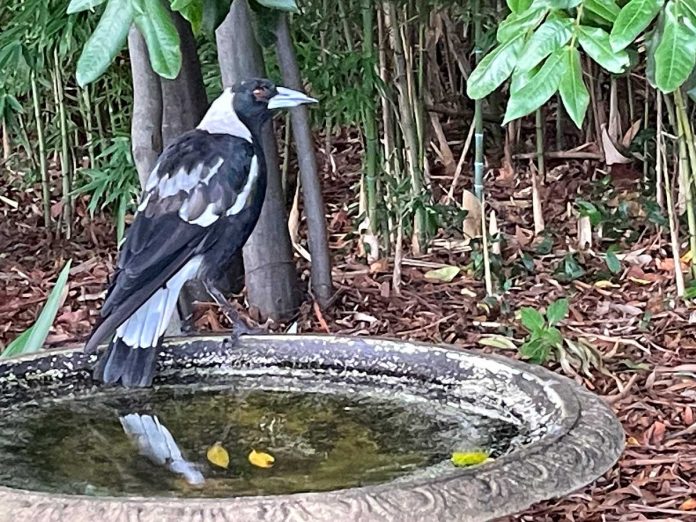The Aussie Bird Count 2022 Results are in, with 3.9 million birds of 620 different species counted in Australia and 1.2 million birds counted in NSW.
Over 77,000 people across Australia braved conditions including record rains and floods to be part of the nation’s largest citizen science project.
The data they collected October 17-23, 2022 will help Birdlife Australia’s researchers better understand the birds we live with and how their populations are changing over time.
One of those 77,000 was Ann Willy, a Lane Cove resident whose backyard bird experience reflects issues SSH covered in our series of articles on urban birdlife in October and November.
Ann heard about the Bird Count just before it began and thought it sounded like fun.
“I have plenty of spare time and a big garden with lots of tall trees and I get a lot of birds. So I thought I’d give it a go.”
She used the app provided by Birdlife Australia and found it very helpful and easy to use.
“I started to get hooked. So I did it every day for two weeks.”
Ann’s isn’t a formal garden; it’s a bit bushy and wild. There are agapanthus and clivia but otherwise she has planted natives. There is a large fig and a lot of gums, including a big stringy bark where magpies nest.
It’s a sheltered garden with a birdbath so a lot of birds come for a bath or a drink.
Her favourites are Maggie May the magpie and her family.
“There are three of them now. First the female moved into our garden. She found a mate and a year passed before they appeared with a chick.
“I go out to have a chat with them. It’s really nice.”
Sometimes she gives the magpies sunflower seeds as treats and it seems they have been leaving presents in return.
“One day my husband saw a blue coat hanger on the paving outside our back door. When I went out to have a look Maggie May came down next it. She looked at it and I looked at it and she looked at it and we chatted.
“I thought she was trying to take it to her nest so I left it there for a few days. Eventually I took it inside. But sometime later there was another blue coat hanger. Since then there have been six more.”
“It’s quite lovely.”
Lorikeets are the most plentiful birds in Ann’s garden and that accords with the results of the Bird Count.
The rainbow lorikeet easily took out the number one spot as most numerous bird — for the ninth year running.
In NSW the next most counted birds were the noisy miner and sulphur crested cockatoo.
Ann gets cockatoos in her garden (which she’s not so keen on) along with tawny frogmouths and king parrots. She also sees red wattlebirds and bush turkeys in the neighbourhood, while crested pigeons nest next door.
She also has a lot of noisy miners. “They are probably the second most dominant birds in our garden. They are quite bossy and chase a lot of things away.
“They even have a go at the magpies. But it’s interesting because they are resident and the magpies are resident and they sort of know who lives in our garden. As long as everyone behaves they tolerate each other.”

Ann doesn’t consider herself a bird nerd or citizen scientist. “I don’t know enough to be a nerd. I’m just someone who likes birds and does as much for them as I can.”
She once did a course on birds at Taronga Zoo; part of continuing education through the University of Sydney.
“We went on excursions to wetlands near Windsor and Cumberland State Forest at West Pennant Hills.
“The guy who took us was amazing. He could identify 15 birds just by their song early in the morning.”
Ann said it wasn’t hard to stick with the Bird Count for two weeks.
“The time went so quickly. It was fun. I tried to increase my count each day as I was learning.”
One thing she learned was that butcherbirds have a lot of different calls. “It was only after I found that one was nesting in the nature strip in my street that I realised it wasn’t a currawong calling. Now I see one nearly every day and it is lovely.”
She said it was interesting to be part of so many people participating in the Bird Count and she was aware of how the count could be a barometer for the health of the environment and decline of bird species.
“I have certainly noticed a change in the birds that we’ve had in our garden.
“We’ve been here for 40 years and I know when we first moved in there were a lot of smaller birds that we don’t see now, like bulbuls, silvereyes and willie wagtails.
“We had pardalotes at one stage. But then we got a cat and the small birds moved out.
“Now we are without cats we have more birds, but not the small ones. I think the noisy miners have a lot to do with it.”
Ann said since the Bird Count she had been paying more attention to birdcalls and trying to identify the birds and see what they were doing.
The Aussie Bird Count was a very rewarding experience, she said. “I’m happy that I’ve done it and I’m sure I’ll do it again next year.”
The 2023 Aussie Bird Count will take place October 16-22.
If you’re keen to submit bird surveys year-round, you can check out Birdlife’s bird monitoring programs: Birds in Backyards and Birdata.





